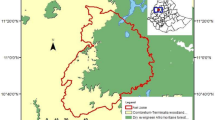Abstract
White-browed titi monkeys (Callicebus discolor) have one of the largest distribution ranges of all titi monkey species, occurring from central Peru to southern Colombia. During a long-term study on the distribution of titi monkeys and other primates in Peru, we conducted extensive surveys in the San Martin Department of northeastern Peru. We encountered Callicebus discolor at the left bank of the Huallaga River, where the species most probably lives in sympatry with endemic San Martin titi monkeys (Callicebus oenanthe). Our study reveals an important extension of its formerly known distribution range. Massive deforestation activities in the region make studies on the habitat preferences of both species difficult, as most titi monkeys are confined to the remaining small remnants of the original forest. Urgent conservation measures are necessary to preserve the last lowland forests of San Martin.

Similar content being viewed by others
References
Aquino, R., & Encarnacion, F. (1994). Primates of Peru. Primate Report, 40, 27–30.
Aquino, R., Terrones, W., Cornejo, F., & Heymann, E. W. (2008). Geographic distribution and possible taxonomic distinction of Callicebus torquatus populations in Peruvian Amazonia. American Journal of Primatology, 70, 1181–1186.
Boveda-Penalba, A. J., Vermeer, J., Rodrigo, F., & Guerra-Vasquez, F. (2009). Preliminary report on the distribution of Callicebus oenanthe on the eastern feet of the Andes. International Journal of Primatology, 30, 467–480.
Cabrera, A. (1900). Estudios sobre una colleción de monos americanos. Anales de Sociedad Espanola de Historia Natural, 9(29), 83–85.
Defler, T. R. (2004). Primates of Colombia. Bogotá: Conservacion Internacional de Colombia.
de Luycker, A. (2006). Preliminary report and conservation status of the Rio Mayo titi monkey, Callicebus oenanthe Thomas, 1924, in the Alto Mayo Valley, Northeastern Peru. Primate Conservation, 21, 33–39.
Elliot, D. G. (1913). A review of the primates 1. New York: American Museum of Natural History.
Felton, A., Felton, A. M., Wallace, R. B., & Gómez, H. (2006). Identification, behavioural observations, and notes on the distribution of the Titi monkeys Callicebus modestus Lönnberg, 1939 and Callicebus olallae, Lönnberg 1939. Primate Conservation, 20, 41–46.
Ferrari, S. F., Iwanaga, S., Messias, M. R., Ramos, E. M., Ramos, P. C. S., da Cruz Neto, E., et al. (2000). Titi monkeys (Callicebus spp., Atelidae: Platyrrhini) in the Brazilian State of Rondônia. Primates, 41, 229–234.
Geoffroy Saint-Hilaire, I. (1851). Description des mammifères nouveaux ou imparfaitement connus de la collection du Muséum d’Histoire naturelle 3: Famille des Singes, Supplément. Archives du Muséum d’Histoire Naturelle, 5, 551–555. +plate 28.
Geoffroy Saint-Hilaire, I., & Deville, E. (1848). Note sur huit espèces nouvelles de singes américains, faisant partie des collections de MM. De Castelnau et Emilie Deville. Comptes Rendus Hebdomadaires des Séances de l’Académie des Sciences de Paris, 27, 498.
Gray, J. E. (1870). Catalogue of monkeys, lemurs and fruit-eating bats in the collection of the British Museum (pp. 54–57).
Hershkovitz, P. (1990). Titis, New World Monkeys of the genus Callicebus: a preliminary taxonomic review. Fieldiana Zoology, 55, 1–109.
Jentink, F. A. (1892). Catalogue systématique des mammifères (singes, carnivores, ruminants, pachydermes, sirènes et cétacés). Muséum d’Histoire Naturelle des Pays Bas, 11, 52–53.
Kinzey, W. G. (1997). New World Primates: Ecology, evolution and behavior (p. 215).
Martinez, J., & Wallace, R. B. (2007). Further notes on the distribution of endemic Bolivian Titi Monkeys, Callicebus modestus and Callicebus olallae. Neotropical Primates, 14, 47–54.
Rowe, N., & Martinez, W. (2003). Callicebus sightings in Bolivia, Peru and Ecuador. Neotropical Primates, 11, 32–35.
Schlegel, H. (1876). Les singes, Simia. Muséum d’Histoire Naturelle de Pays-Bas, 12, 230–241.
Thomas, O. (1924). New Callicebus, Conepatus, and Oecomys from Peru. Annals and Magazine of Natural History, 9(14), 286–288.
van Roosmalen, G. M., van Roosmalen, T., & Mittermeier, R. A. (2002). A taxonomic review of the titi monkeys, genus Callicebus Thomas 1903, with the description of two new species, Callicebus bernhardi and Callicebus stephennashi, from Brazilian Amazonia. Neotropical Primates, 10(Supplement), 1–52.
von Spix, J. B. (1823). Simiarum et vespertiliarum Brasilienses species novea (pp. 18–23).
Acknowledgments
This study is part of a long-term project for the conservation of Callicebus oenanthe, coordinated by the Peruvian NGO Proyecto Mono Tocón and initiated by Le Conservatoire pour la Protection des Primates of the primate park La Vallee des Singes of Romagne, France. We thank Dario Lorente Hollingworth, José Tito Villacis del Castillo, César Manuel Paredes Arévalo, Carlos Enrique Zabarburú Chicana, Julio Rengifo Chávez, Paulino Rafael Altamarino, and Antonio J. Bóveda-Penalba for companionship during the study. We thank Eckhard Heymann, Rob Wallace, and an anonymous reviewer for their comments on the manuscript. We also thank Cécile Callou and Jacques Cuisin for allowing us to study the collection of the Museum Nationale d’Histoire Naturelle de Paris, and René Dekker and Hein van Grouw for access to the collection of Naturalis in Leiden. We also thank the personnel of the Naturalis Library. Financial support for the study was provided by La Vallée des Singes, the Friends of Blackpool Zoo, Primate Conservation Inc., Apenheul Primate Park, Twycross Zoo, the Zoological Society of London, Eskilstuna Zoo, the Shaldon Wildlife Trust, Zodiac Zoos, and Bellewaerde Park. We thank DGFFS for authorization (Authorization 255-2009-AG-DGFFS-DGEFFS) to conduct this study. Our work would not have been possible without the help and hospitality of the Peruvian people, who were always friendly and happy to respond to our questions.
Author information
Authors and Affiliations
Corresponding author
Rights and permissions
About this article
Cite this article
Vermeer, J., Tello-Alvarado, J.C., Moreno-Moreno, S. et al. Extension of the Geographical Range of White-browed Titi Monkeys (Callicebus discolor) and Evidence for Sympatry with San Martin Titi Monkeys (Callicebus oenanthe). Int J Primatol 32, 924–930 (2011). https://doi.org/10.1007/s10764-011-9511-1
Received:
Accepted:
Published:
Issue Date:
DOI: https://doi.org/10.1007/s10764-011-9511-1




